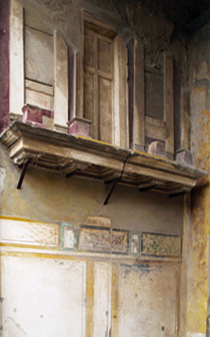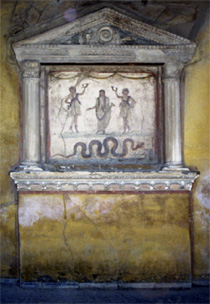 1
1Two temple facades, on opposite walls in the fauces of the Casa del Fauno, unambiguously evoke spiritual protection (fig.1&2). In order to enter or leave the house occupants and visitors passed between them, thus reminding them that they were entering a special place. Apotropaic imagery associated with the door and the fauces introduced the concept that the house was protected by the gods, once inside lararia reinforced its sanctuary-like appearance.
Lararia
In addition to apotropaic motifs associated with thresholds and the image of the inward facing structure of the house, the ubiquitous presence of lararia (house shrines) made a major contribution to the concept of the house as sanctuary. These varied from impressive pieces of architecture located in socially important parts of the house, such as the atrium, to simple aediculae niches containing small statues and paintings of lararia on kitchen, bedroom and garden walls.
The majority of houses contained more than one shrine and collectively these gave it a religious or spiritual atmosphere. Generally speaking, domestic shrines resembled temples and provided the focus for the daily worship of the household gods and ancestor spirits (fig.3). It was thought that the tutelary spirits had the power to protect and bring harmony to the domus if appropriate respect and worship was bestowed upon them (fig.4). Devotion to them began in antiquity and continued in its pagan form until the third century AD, when in-house shrines became increasingly dedicated to Christian deities. In contrast, the fetish nature of pagan worship embedded the gods, ancestors and tutelary spirits into the fabric of the house, with objects such as the lararium acting as a focal point. Hence, honouring them signified honouring the house itself, as if it possessed an anthropomorphic persona. Most houses contained more than one lararium.
 1
12 Casa del Faunos3 Temple-like lararia in the atrium of the Casa del Menandro, Pompeii
4 Casa dei Vettii – tutelary spirits in a courtyard lararium
 4
4
|